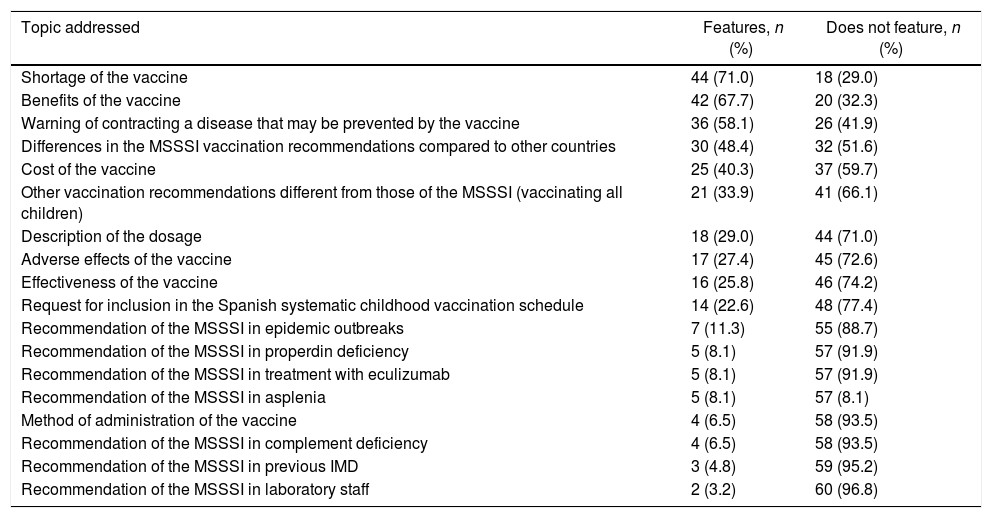YouTube™ is an important source of health information. The aim of this study was to analyse the characteristics of the videos published in Spanish on YouTube™ about the serogroup B meningococcal vaccine.
Methods and materialsIn February 2018, a search was made on YouTube™ using the keywords “Vacuna meningitis B”, “Bexsero®”, and “Vacuna Bexsero®”. A univariate analysis was carried out to evaluate the association between the authorship of videos (health professionals or others) and the rest of variables (kind of publication, tone of the message, and adherence to vaccination recommendations approved by the Ministry of Health of Spain, among others).
ResultsA total of 62 videos were analysed, of which 45.2% were produced by television channels, and 58.1% supported the use of the vaccine. Only 11.3% mentioned at least one of the vaccination recommendations of the ministry. There were significant differences in the frequency of the vaccine mode of administration depending on the authorship [OR (95% CI: 18.75 (1.73–203.21)], description of its posology [OR (95% CI: 6.36 (1.57–25.75)], and its price [OR (95% CI: 0.11 (0.01–0.95)], and in some vaccination recommendations by the ministry [deficit of properdin, treatment with eculizumab, and asplenia: OR (95% CI: 9.19 (1.32–63.87)].
ConclusionsThere is a difficulty in obtaining information on vaccination recommendations adhering to those approved by the ministry. Users should be encouraged to consult videos produced by healthcare professionals when they seek information about this vaccine on YouTube™.
YouTube® constituye una importante fuente de información sanitaria. Nuestro objetivo fue analizar las características de los vídeos publicados en castellano en YouTube® sobre la vacuna frente al meningococo B.
Material y métodosEn febrero de 2018 se efectuó una búsqueda en YouTube® usando las palabras clave «Vacuna meningitis B», «Bexsero®» y «Vacuna Bexsero®». Se realizó un análisis univariante para evaluar la asociación entre el tipo de autoría del vídeo (profesionales sanitarios y otros) y el resto de variables (tipo de publicación, tono del mensaje y adherencia a las recomendaciones de vacunación del Ministerio de Sanidad de España, entre otras).
ResultadosSe analizaron 62 vídeos; un 45,2% fueron elaborados por canales de televisión y el 58,1% apoyaron usar la vacuna. El 11,3% mencionaron al menos una de las recomendaciones de vacunación del ministerio. Según el tipo de autoría hubo diferencias significativas en la frecuencia con la que en los vídeos se trató el modo de administrar la vacuna (OR [IC 95%]=18,75 [1,73-203,21]), posología (OR [IC 95%]=6,36 [1,57-25,75] y precio (OR [IC 95%]=0,11 [0,01-0,95]), y en algunas recomendaciones de vacunación del ministerio (déficit de properdina, tratamiento con eculizumab y asplenia: OR [IC 95%]=9,19 [1,32-63,87]).
ConclusionesExiste una dificultad para obtener información sobre recomendaciones de vacunación adheridas a las aprobadas por el ministerio. Se debe promocionar en los usuarios la consulta de vídeos elaborados por profesionales sanitarios cuando busquen información sobre esta vacuna en YouTube®.
Artículo
Comprando el artículo el PDF del mismo podrá ser descargado
Precio 19,34 €
Comprar ahora








